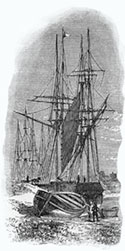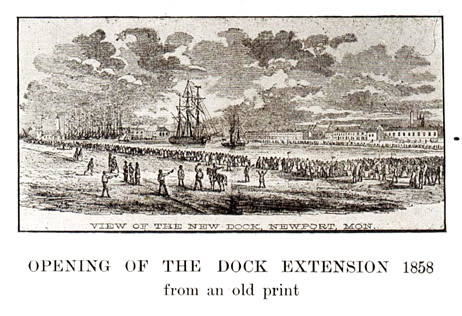Maritime History of Newport
By Peter Brown
© Peter Brown 2024
The Town Dock (1842 - 1930)
In 1835, after years of lobbying, an Act was passed “for making and maintaining a Dock and other works in the Port of Newport, in the County of Monmouth, with a Railway and Stone Road therefrom.”[1] Work on the Town Dock began on 1 December 1835, when Mayor John Owen cut the first sod “to the sound of the bells of St. Woolos, the firing of guns and the celebrations of the Navvies, who had been supplied with several barrels of Castle Brewery beer for the occasion.”[2]
After some technical and financial difficulties during the construction, the official opening of the dock took place on 10 October 1842, at a cost of about £195,000 raised by shares and loans.[3] This was known as the Outer Basin and covered an area of 4 acres, although the total size of the dock with its warehouses and wharves was 24 acres. The dock had an entrance lock that was said to be the largest sea lock in the world at the time, claiming to be large enough to hold the S.S. Great Western, then the largest ship afloat.[4] The Newport Steam Tug Company was established in 1840 in preparation for the dock opening.[5]
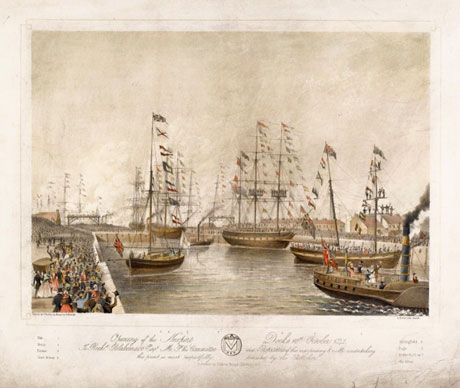
Opening of Newport Docks in 1842 by Joseph Walter (1783-1856)
In the collection of Newport Museum and Art Gallery.
The opening was marked by a programme of festivities that attracted tens of thousands of visitors to the town. In the morning, a mile-long procession proceeded along High Street through Commercial Street and Commercial Road towards the Dock. Near the head of the procession, the Mayor and Aldermen travelled in open carriages, followed by significant clubs and societies and many inhabitants of the town. At 10 o’clock, the lock gates were opened to the sound of “the shouts and cheers of the spectators, the thunder of cannons, firing of musketry and pealing of bells.” The first vessel to enter the dock was the Henry. Following the official opening, the events continued throughout the day, including a dinner for 300 gentlemen of the area at the National School, boat races on the dock reservoir and a firework display at Rodney Wharf. In the evening, a ball was held for the gentry at the King’s Head Hotel. The clubs and societies also held their dinners and balls at inns throughout Newport, and a Tradesman’s Ball at the Steam Packet Inn was reported to have “kept up with much spirit until morning.”[6]
Three weeks after the Town Dock opened (2 Nov 1842), one of the Tidewaiters, George Rogers, fell into the lock while crossing the bridge at night and drowned.[7]
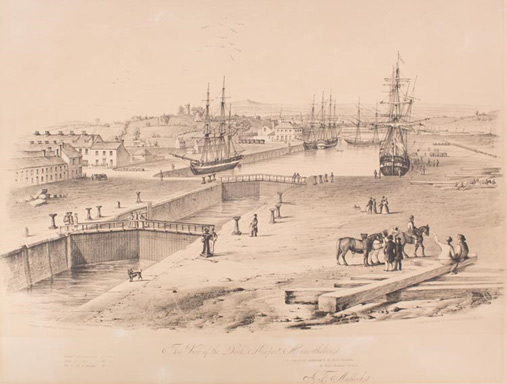
The Town Dock at Newport soon after it opened in 1842, by James Flewitt Mullock (1818-1892).
Copyright Gwent Archives. Reproduced by kind permission of Gwent Archives. / Hawlfraint Archifoedd Gwent. Atgynhyrchwyd drwy garedigrwydd Archifoedd Gwent.
Creative Archive Licence for non-commercial educational use.
One side of the docks was devoted to coal shipments, while the other handled imports and general exports. The trade from the Town Dock was mainly in timber, with the whole of one end laid out as a timber slipway. Other shipments were grain, hay and potatoes, mainly carried by smaller vessels.[8] The Town Dock had an assortment of fixed and movable hydraulic cranes, served by the Hydraulic Generating Power Station.[9]
The increase in trade with the Town Dock can be seen by comparing the figures for the 1820s with those for 1846:[10]
- In 1825, there were 44 vessels, totalling 3,029 tons, and 216 men belonging to the port. In 1846, 84 vessels of 9,831 tons and 501 men.
- The receipt of duties for 1823 was £1,203; in 1846, it was £11,192.
- The vessels inwards from foreign ports in 1823, in ballast, were 11, in 1846, 134; with cargoes in 1823, 2, but in 1846, 78.
- Vessels with cargoes to foreign ports from Newport in 1823 were 58, and in 1846, 577.
- Vessels coastwise with inward cargoes, in 1823 were 1,351, and in 1846, 1,753. Outwards figures were 1823, 6,963 and 1846, 8,412.
- The value of goods entered at the Customs for exportation in 1846 was £394,531. In the same year, 493,582 tons of coal were sent coastwise.
The trade figures for 1844 were as follows for ships to and from foreign parts:[11]
|
Inwards |
Outwards |
||||
|
Ships |
Tons |
Men |
Ships |
Tons |
Men |
With cargo |
51 |
9,994 |
456 |
955 |
156,077 |
8,064 |
In ballast |
353 |
50,654 |
2,709 |
6 |
1,886 |
78 |
France, Holland and Spain were the main European customers, but ships also traded with Asia, and much Monmouthshire coal was shipped to the Caribbean islands.[12]
By contrast to 1844, the figures for 1850 show the following expansion in cargo and reduction in ballast:[13]
|
Inwards |
Outwards |
||||
|
Ships |
Tons |
Men |
Ships |
Tons |
Men |
With cargo |
133 |
18,781 |
950 |
708 |
170,867 |
3,463 |
In ballast |
88 |
28,962 |
1,124 |
6 |
1,035 |
40 |
By 1847, the growing export of minerals was approximate to Cardiff's.[14]
|
1829 |
1845 |
1846 |
Coal (tons) |
471,625 |
676,831 |
647,816 |
Iron (tons) |
108,726 |
216,704 |
215,014 |
Exports also included tin plates and merchandise, including oak timber and bark. The value of the iron probably averaged £8 10s. per ton, and coal 8s. 6d. per ton. There was a slight reduction in coal exports in 1846 compared to the three previous years due to several coal owners removing some of their shipping trade to Cardiff.
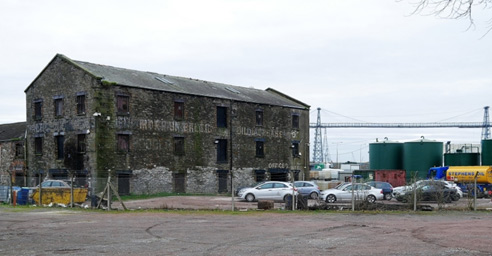
The Baltic Oil Works – a surviving building from the Town Dock. Originally constructed around 1844, it formerly abutted the western side of the Old Town Dock. Homfray may have supplied the cast iron from his Tredegar Ironworks.[15]
(Photo by Michael Benjamin (2017) at the British Listed Buildings website)
Kelly’s Directory for 1848 presents a glowing account of the state of trade and the hopes for the future:[16]
The traffic of five great mineral valleys – Crickhowell, Pontypool, Ebbw Vale, Sirhowy and Rumney – converges at this their natural outlet to the sea; and when we state that the mineral wealth thrown off by Monmouthshire now amounts to nearly three millions annually, our prospective view cannot be deemed extravagant. Newport commands another advantage in a magnificent river, with spring tides varying from 36 to upwards of 40 feet, and it will very soon possess railways to the east, west and north. Bristol, now rising from her lethargy, begins to be jealous.
The chief increase in the coal trade was with the white-ash coal, largely used for steam purposes. Until the coal duty was repealed, Newport and Cardiff possessed a peculiar advantage under the powers of an Act passed early in the 19th century. That allowed them a right to ship coals free of duty, which was extended to all ports “east of the Holms” (Flat Holm and Steep Holm), thus shutting out all the ports further west. The annual shipments from Newport to Bridgwater alone exceeded 100,000 tons under the monopoly, but under free trade in coal, the price at Cardiff had been reduced by 1s. 6d. per ton, to the level of Newport, to meet the competition. As a result, exports there had become enormous.[17]
The coastal trade in 1850 saw 1,840 ships bring in 92,811 tons of goods, and 7,710 ships leave with 424,386 tons.[18] The trade at that time was summarised this way by Dawson, who published a book in 1932 on trade and commerce in Newport:[19]
British ships left the Usk outward bound for the Seven Seas. Cargoes from Uskside were destined to the Far East and Far West, and from the mines and furnaces of Monmouthshire, coal and iron went through Newport round the Cape of Good Hope and Cape Horn to the ports of China and Peru.
The Town Dock extension (1858)
For some years the Town Dock served the needs of the port, but in 1854 an extension was agreed under the Newport Dock Company Act. Work began in 1856, and the extension, known as the Inner Basin, covered 7½ acres and was opened on 2 March 1858. The opening celebrations included cannons, illuminations, fireworks, bands playing ‘Rule Britannia’, a public dinner at the King's Head, and a Grand Ball at the Town Hall. The Great Britain, gaily decked with flags, was towed to the upper dock by the tugboat Neptune, the latter having on board the Mayor (William Williams, Esq.), the Corporation, and Samuel Homfray, Esq., Chairman of the Dock Company.[20] The Cardiff and Merthyr Guardian published a detailed account of the opening on 6 March 1858.[21]
The construction cost was £64,000, but it soon became apparent that additional capacity was badly needed as the annual shipments had risen to 250,000 tons and were still rising.[22] One side of the docks was devoted to coal, while the other handled imports and general exports using a series of hydraulic cranes.
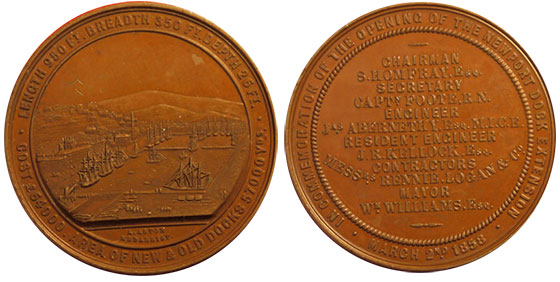
Medal for the opening of the Town Dock extension, 1858.
(Newport Past website)
Shipping capacity increased significantly with the extension to the Town Dock, and the 1850s also saw the construction of new railway access to the Town Dock and quays, replacing the earlier tramroads with greater capacity and efficiency.[23] These improvements allowed the Customs receipts between 1871 and 1874 to increase from £46,776 to £55,329 and the Excise receipts from £7,149 to £11,008.[24]
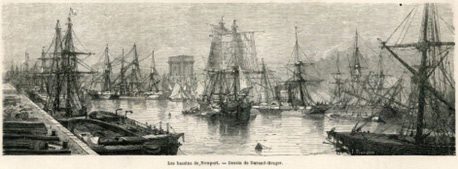
The Town Dock in 1865, engraved by F. Pierdon.
From In Around the World: New Journal of Travel (a French Publication).
A river survey was made for the Harbour Commissioners in 1867 (with additions in 1870), showing the two basins of the Town Dock with the entrance lock at the southern end.[25] This shows the final layout of the Town Dock, just before the full development of the later docks further south. The area of the Pillgwenlly Pill and Tredegar Wharf is west of the lock and later became the Alexandra Dry Dock. Just north of the Town Dock stands the shipyard and graving docks at Jack’s Pill, which later became Cashmore's breakers yard.
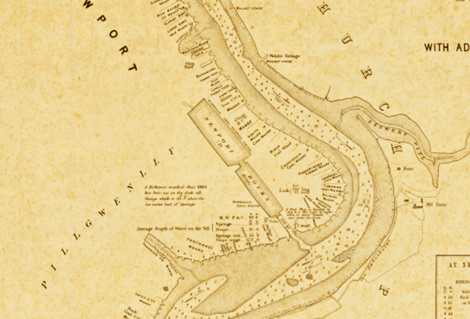
The entire development of the Town Dock, shown in the river survey made for the Harbour Commissioners in 1867 (with additions in 1870).
A report from July 1872 details the arrivals during the previous week, which were described as numerous and varied. One ship was the steamer Corsair, direct from Charente (south-west France), with about 3000 gallons of brandy consigned to Mr William Webb of Aberbeeg. Direct imports would have been more frequent were there more extensive vaults and warehouses for bonding wines and spirits at the port. The Chesapeake steamer was loading 1000 tons of railway iron for foreign ports, but her length was too great to admit to the docks, so she was loaded on the riverside.[26]
A major accident occurred on the night of 10 January 1882 when two steamers came up the river to enter the Town Dock.[27] They were the Primus of Whitby, with a cargo of pig iron, and the Constancia of Bilbao, carrying 850 tons of iron ore. The ships jammed while docking, so the lock gates could not be closed. As a result, the vessels lowered on the receding tide, causing extensive damage to both ships, such that the Primus could not be repaired. Although there were no injuries recorded, the accident cost was substantial. In addition to the costs with the ships, other ships were trapped in the dock, and there were claims for ‘demurrage’ in compensation for the delays.
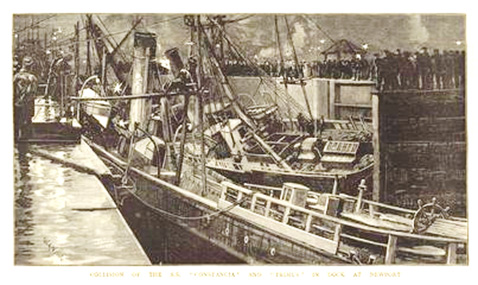
The accident with the Constancia and Primus in the Town Dock in 1882.
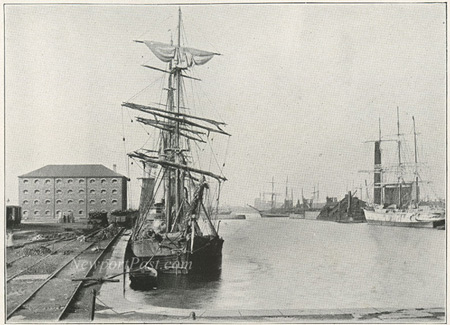
Grain warehouse at the Town Dock.
(From the Newport Year Book, 1903)
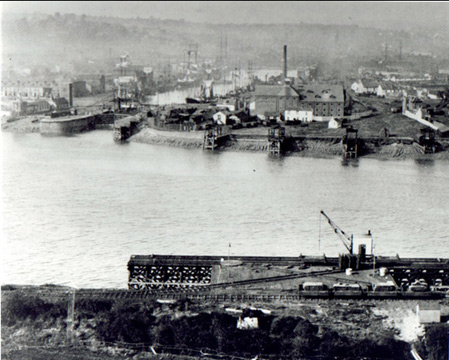
This photograph from around 1900 shows the Town Dock across the river, with its entrance lock and coal hoists along the river. The wharf in the foreground belonged to Lysaghts Steelworks.
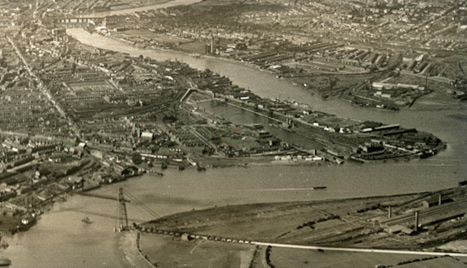
The Town Dock can be seen in this aerial photograph from the southwest in the 1920s.
The Power Station that served the Town Dock was closed in 1902 when the hydraulic power was supplied by one of the three stations at the Alexandra North Dock. Four coal hoists were still operating in 1914. The growth in the size of the ships and the development of the newer docks downstream led to a reduction in the need for the Town Dock, which finally closed in October 1930 after 88 years of service.[28] The water from the Town Dock Feeder was diverted to the Alexandra Docks; much of the equipment was transferred to the Alexandra Docks, and the Town Dock was filled in two years later. The only part of the dock to be seen today is the entrance lock near the Blaina Wharf pub.
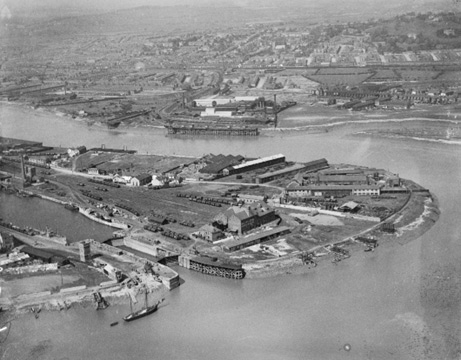
Aerial view of Town Dock of 1842 photographed on 6 May 1921, showing a battleship from the recently finished First World War in the dock awaiting breaking; contrast with the schooner sailing in the river.
Creator: Aerofilms Ltd. (06/05/1921)
Crown Copyright: Royal Commission on the Ancient and Historical Monuments of Wales.
Reproduced by kind permission under the Creative Archive Licence for non-commercial educational use.
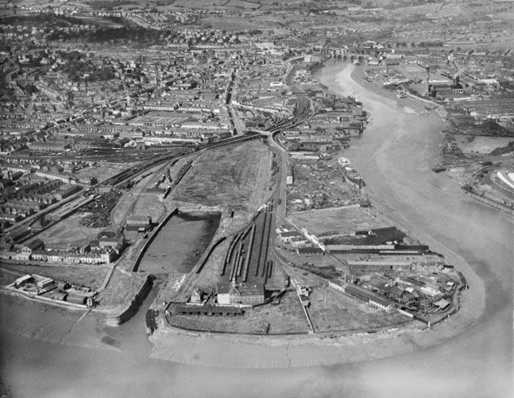
Aerial view of the Town Dock in 1937 looking northwest, after it had been partly filled in. The octopus bridge and Cashmore’s breaking yard are visible, with a ship being dismantled.
Creator: Aerofilms Ltd. (15/09/1937)
Crown Copyright: Royal Commission on the Ancient and Historical Monuments of Wales.
Reproduced by kind permission under the Creative Archive Licence for non-commercial educational use.
References
1 Dawson, J. W. (1932) Commerce and Customs: A History of the Ports of Newport and Caerleon, 63.
Online at: https://archive.org/details/commerce-and-customs-newport
2 Newport Harbour Commissioners website.
Online at: https://www.newportharbourcommissioners.org.uk/
3 Hutton, John (1996) The Newport Docks & Railway Company, 60.
4 Maylan C.N. (1991) Proposed Usk Barrage Initial Archaeological Assessment, GGAT Report No. 91/01, 18-19.
Online at: https://walesher1974.org/her/app/php/herumd.php?level=2&group=GGAT&docid=301464088&linktable=her_source1_link ; Scott, J. M. (1847) The ancient and modern history of Newport, Monmouthshire, 89.
Online at: https://play.google.com/books/reader?id=6fDBCw31psEC&pg=GBS.PP1&hl=en
5 Scott, 93.
6 Newport Harbour Commissioners website.
7 Dawson, 123.
8 Hutton, 60-61.
9 Hutton, 61.
10 Scott, 106-7.
11 Dawson, 70.
12 Dawson, 70.
13 Dawson, 72.
14 Kelly’s Newport Directory, 1848.
Online at: https://www.newportpast.com/records/directories/kelly1848/introduction.php
(Extracted from The Book of South Wales and the Bristol Channel by Cliffe)
15 https://britishlistedbuildings.co.uk/300018173-baltic-oil-works-pillgwenlly
16 Kelly’s Newport Directory, 1848.
17 Kelly’s Newport Directory, 1848.
18 Dawson, 72.
19 Dawson, 73.
20 Star of Gwent, 6th March, 1858.
Online at: https://www.newportpast.com/nfs/y50t59/y1858.htm
21 https://papuraunewydd.llyfrgell.cymru/view/3091155/3091161?fbclid=IwAR1hp5WAlelMG2ONiguWfZX2dPL-pzZojY7dtKpEmGviqrlJYcJpYLl20hM
22 Hutton, 60-1.
23 Skillern, William J. (1960) ‘The Railways of Newport’, The Railway Magazine, July, No. 711, Vol. 107.
Online at: http://www.newportpast.com/transport/rail.php
24 Dawson, 81.
25 http://www.newportpast.com/gallery/maps/river_usk_1870.htm
26 Star of Gwent, 16th July 1872: http://www.newportpast.com/nfs/y70t79/y1872.htm
27 Dawson, 110-1.
28 Hutton, 61.
Back to Index of Peter Brown's "Maritime History of Newport "

